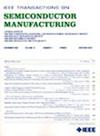考虑数字孪生模型可重用性的ALD sio2后退火和蚀刻过程中间变量建模
IF 2.3
3区 工程技术
Q2 ENGINEERING, ELECTRICAL & ELECTRONIC
引用次数: 0
摘要
在本研究中,我们研究了一个具有多个过程的数字孪生模型。一般来说,在半导体制造过程中,前面的工艺会影响后面的工艺。因此,为了构建可重用的模块化模型,需要定义和简洁地表示过程之间的相互影响。我们建立了一个数字孪生模型,涉及原子层沉积(ALD)形成的氧化膜的后退火和湿蚀刻,作为一个案例研究。我们开发了一个模块化模型,该模型基于通过物理分析提取的中间变量来分离过程。从预测结果中获得的高决定系数表明,这些中间变量充分反映了前面过程的影响。此外,我们探讨了在面向对象编程(OOP)框架中使用类结构分析来改进模型可重用性的概念。我们注意到需要将基于物理的中间变量封装在适当的类中,以分离特定于进程和设备的描述。封装的中间变量间接表示过程影响,实现了类内部模型的模块化。这些发现有助于减少模型之间的依赖关系,从而有助于提高模型的可重用性。本文章由计算机程序翻译,如有差异,请以英文原文为准。
The Modeling of Post-Annealing and Etching Processes of ALD SiO₂ Using Intermediate Variables Considering Digital Twin Model Reusability
In this study, we examined a digital twin model that has multiple processes. Generally, previous processes affect subsequent processes in the semiconductor manufacturing process. Therefore, to construct reusable modular models, the mutual influences between processes should be defined and concisely represented. We built a digital twin model involving the post-annealing and wet etching of an oxide film formed by atomic layer deposition (ALD), as a case study. We developed a modular model that separated processes based on intermediate variables extracted through physical analysis. The high coefficient of determination obtained from the prediction results suggests that these intermediate variables sufficiently captured the effect of the preceding processes. Further, we explored concepts for improving model reusability using class structure analysis within an object-oriented programming (OOP) framework. We observed the need for encapsulating physics-based intermediate variables within appropriate classes to separate process- and device-specific descriptions. The encapsulated intermediate variables indirectly represented process influence and enabled the modularization of class-internal models. These findings help in reducing dependencies between models, thereby contributing to improved model reusability.
求助全文
通过发布文献求助,成功后即可免费获取论文全文。
去求助
来源期刊

IEEE Transactions on Semiconductor Manufacturing
工程技术-工程:电子与电气
CiteScore
5.20
自引率
11.10%
发文量
101
审稿时长
3.3 months
期刊介绍:
The IEEE Transactions on Semiconductor Manufacturing addresses the challenging problems of manufacturing complex microelectronic components, especially very large scale integrated circuits (VLSI). Manufacturing these products requires precision micropatterning, precise control of materials properties, ultraclean work environments, and complex interactions of chemical, physical, electrical and mechanical processes.
 求助内容:
求助内容: 应助结果提醒方式:
应助结果提醒方式:


